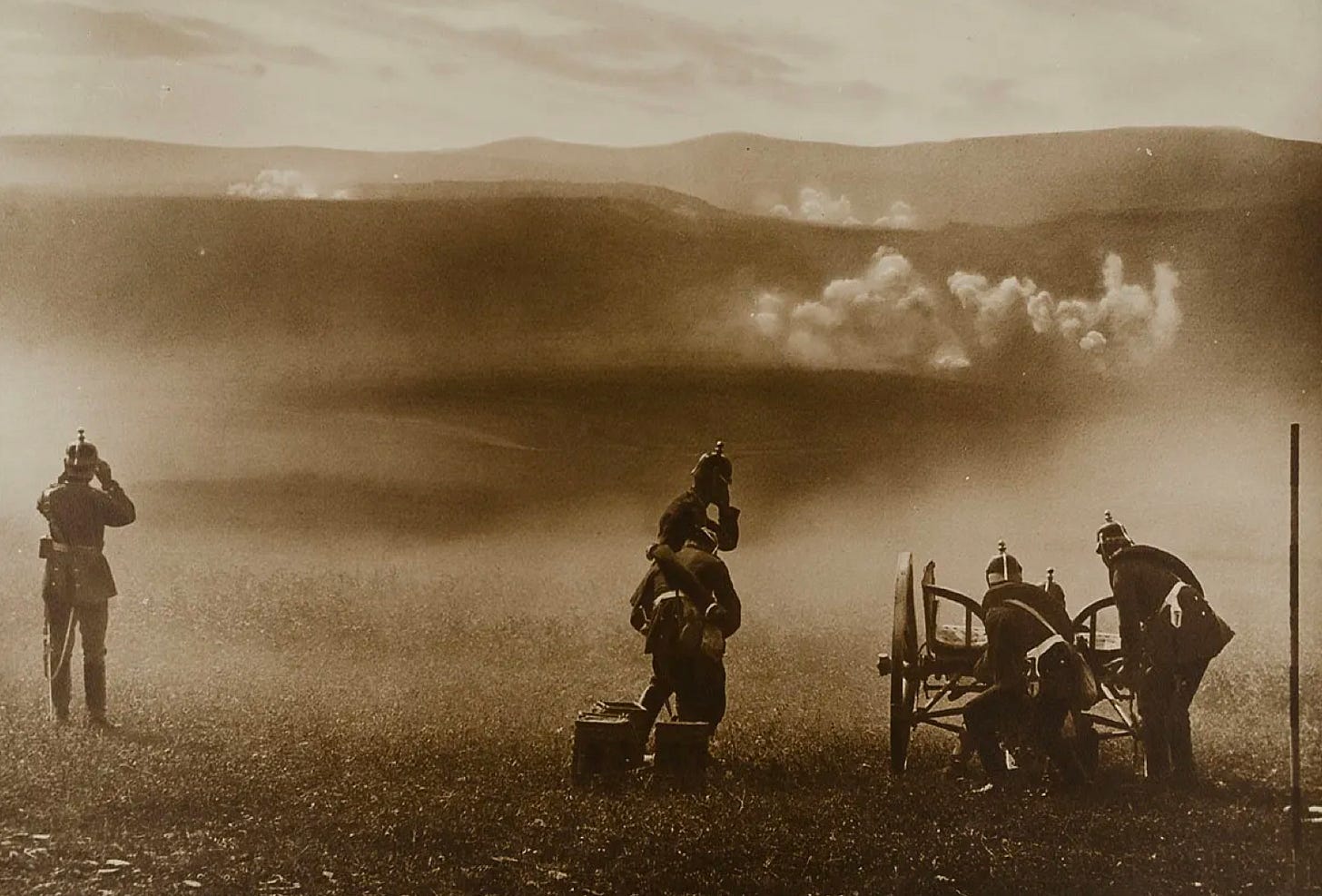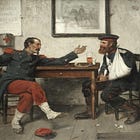Chasing Shiny Objects
Some seasonal thoughts on innovation in the military sphere
Recently, on Fire for Effect, B.A. Friedman concluded his “Rage Against the RMA” with a minor Jeremiad on the subject of shiny objects.
The US especially continually chases so-called Revolutions in Military Affairs (RMA) promised by the next new gizmo. No wait, not that one, the next one. This one definitely. No, not that one either but certainly this one.
Maybe we’d be better at innovating if we didn’t chase every single shiny object.
In honor of Captain Friedman, and his service in the field artillery of the US Marine Corps, I will expand upon this thought with the tale of the way a particularly shiny object put the French Army of the early days of the last century on the primrose path to long-barreled, high-velocity, flat-trajectory perdition.
In the 1890s, Émile Rimailho did much of the heavy lifting on a revolutionary recoil-absorbing mechanism for field guns. In particular, he employed a clever combination of compressed air and mineral oil to absorb the rearward force generated when a cannon was fired and return the barrel to the exact place it had occupied beforehand. As a result, the first weapon fitted with Captain Rimailho’s contraption, the famous 75mm field gun Model 1897, could fire three, four, or even five shells in the time it took any other field gun of its day to send a single round downrange.
When the shells in question carried shrapnel, this remarkable rate of fire allowed the new field gun to create a rafale, a storm of lead balls that promised to inflict great harm upon men and horses moving in the open. Indeed, the prospect of such power was so alluring that many French officers of the first decade of the twentieth century argued that the arrival of the new gun doomed all field pieces of larger sorts to the dustbin of hoplophile history. (This belief soon acquired the moniker of soixantequinzeboutisme, which translates as “seventy-five is the limit-ism.”)
Rimailho thought otherwise. He believed that the ability of the new “seventy-five” to wreck havoc upon troops in the open would quickly convince said troops to take shelter. In particular, he was convinced that the proliferation of fast-firing field guns on the battlefield would lead to a great deal of digging. Thus, he concluded, the natural complement to the fast-firing gun was a fast-firing howitzer that could drop lots of high explosive on top of trenches.
Alas, few of Rimailho’s contemporaries shared his enthusiasm for second-order implications. Thus, rather than getting the resources needed to create an entirely new fast-firing howitzer, he was obliged to make do with a program to modify an existing piece of obsolete hardware. Thus was born the howitzer that bore Rimailho’s name, a Frankenstein’s monster that proved far heavier, and far less reliable, than the piece that the inventor had in mind. (Because of the excess weight, the Rimailho’s howitzer traveled in two pieces, and thus had to be assembled before it could fire. What was worse, when the howitzer fired on distant targets, the barrel would often separate itself from the recoil mechanism.)
To add insult to this injury, the French Army bought but a handful of the new (but not entirely new) howitzers. Thus, when war broke out in 1914, it possessed forty of Rimailho’s field guns for every one of his howitzers.
As Rimailho had predicted, it did not take long before the lead-filled skies over France and Flanders convinced soldiers to take up their spades, thereby depriving both the original seventy-five and its many imitators of most of their power. This proved to be a boon for the Germans, who were well supplied with heavy field howitzers of their own. (Better yet, thanks to the stocks of shells set aside for the defense of fortresses, the Germans possessed plenty of projectiles of types that could be fired by such weapons.)
Eighteen years would pass before the French authorities began to acquire heavy field howitzers comparable to the one that Rimailho had imagined in the late 1890s (and the German armies had adopted in 1902.) What was worse, an additional year and a half would be needed to manufacture enough weapons of that sort to enable French gunners to compete, on equal terms, with their German counterparts.
Sources:
Jules Challéat L'artillerie de terre en France pendant un siècle : histoire technique (1816-1919): Tome II, 1880-1910 (Paris: Charles-Lavauzelle, 1935) pages 361, 431, 487-498
École Militaire de Génie, Cours d'artillerie. 2e partie, Caractéristiques des matériels en service (Fontainebleu: Lithographie de l’école, 1914) pages 15-17
Ministère de l'armement et des fabrications de guerre Renseignements sur les matériels d'artillerie de tous calibres en service sur les champs de bataille des armées françaises (Paris: Imprimerie Nationale, 1918) pages 153-156





As is often the case, a particularly effective weapon is only part of the solution. The combination of weapons acting in an orchestrated fashion give an organization the synergy required to make the total exceed the sum of the parts. The proverbial “game changer” is often not a game changer at all. The very heart of the combined arms concept rests on orchestrating multiple superb systems into an outstanding team. The efficiency experts will championed a new technology without a full grasp of the parts required to support it. While I dislike sports analogies they are at times helpful. The great quarterback is not very effective without an offensive line, running backs and receivers.
The new EAOB concept rests on a silver bullet concept of the hidden truck with a missile to take out the ever growing Chinese Navy with little thought to the full spectrum complex equipment and seamless interactions required. While the German V-1 and V-2 Missiles were spectacular their impact on the outcome of the war were insignificant. For the Germans the juice was not worth the squeeze.
Thomas Kuhn wrote in The Structure of Scientific Revolutions that there could in actuality be more than one revolution ongoing simultaneously and that they may or may not all come to fruition at the same time. Of course, he also wrote that his conception of the scientific revolution would not apply beyond the hard sciences but in this I believe he erred because what is actually under discussion here is not the science but the ins and outs of how the human mind processes what the science is saying. And in support of Douglas C Rape, I would note that there are numerous historical examples in which the technology of a new weapon or a new concept would come first and only afterwards would one or more someones look at it and say, "Hey, I know what we can do with this new thing" and would begin to develop tactics and operations applications and concepts that bring the change to full fruition.